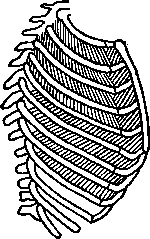Voice Training In Speech And Song - online tutorial
The Structure And Use Of The Vocal Organs, And The Means Of Securing Distinct Articulation.
| Share page | Visit Us On FB |
|
THE BREATHING APPARATUS. |
19 |
||
|
25. The Chest.—The chest or thorax is a large cavity enclosing the heart and the lungs (Fig. 13) ; its walls are composed partly of bone and partly of muscle. The bones are arranged in a cage-like form; the breastbone or sternum in front, the ribs at the sides, and the spine |
|||
 |
|||
|
|
|||
|
Fig. 12.—The Side of the Chest.
Showing the twelve Ribs, attached to the twelve Dorsal Vertebrae. Note how trie Cartilages increase in length. The muscles joining the ribs are the Intercostals, the External Intercostals in the first four intercostal spaces, the Internal Intercostals in the second four intercostal spaces and between the Costal Cartilages.
(twelve dorsal vertebrae) at the back (Fig. 12). The spine curves in a backward direction and so increases the size of the chest cavity. This enlargement of the back of the chest is still further increased by a backward bulging of the ribs on each side of the spinal column. There are twenty-four ribs in all, twelve on each side—the same number in the male as in the female; they are fixed by joints to the spine at the back and to the sternum by cartilages in front; they are placed obliquely, being higher at the back than in front; they somewhat resemble a bow in |
|||